Different molecular mechanisms causing 9p21 deletions in acute lymphoblastic leukemia of childhood
- PMID: 19484265
- PMCID: PMC2762534
- DOI: 10.1007/s00439-009-0689-7
Different molecular mechanisms causing 9p21 deletions in acute lymphoblastic leukemia of childhood
Abstract
Deletion of chromosome 9p21 is a crucial event for the development of several cancers including acute lymphoblastic leukemia (ALL). Double strand breaks (DSBs) triggering 9p21 deletions in ALL have been reported to occur at a few defined sites by illegitimate action of the V(D)J recombination activating protein complex. We have cloned 23 breakpoint junctions for a total of 46 breakpoints in 17 childhood ALL (9 B- and 8 T-lineages) showing different size deletions at one or both homologous chromosomes 9 to investigate which particular sequences make the region susceptible to interstitial deletion. We found that half of 9p21 deletion breakpoints were mediated by ectopic V(D)J recombination mechanisms whereas the remaining half were associated to repeated sequences, including some with potential for non-B DNA structure formation. Other mechanisms, such as microhomology-mediated repair, that are common in other cancers, play only a very minor role in ALL. Nucleotide insertions at breakpoint junctions and microinversions flanking the breakpoints have been detected at 20/23 and 2/23 breakpoint junctions, respectively, both in the presence of recombination signal sequence (RSS)-like sequences and of other unspecific sequences. The majority of breakpoints were unique except for two cases, both T-ALL, showing identical deletions. Four of the 46 breakpoints coincide with those reported in other cases, thus confirming the presence of recurrent deletion hotspots. Among the six cases with heterozygous 9p deletions, we found that the remaining CDKN2A and CDKN2B alleles were hypermethylated at CpG islands.
Figures



Similar articles
-
Molecular characterization of 9p21 deletions shows a minimal common deleted region removing CDKN2A exon 1 and CDKN2B exon 2 in diffuse large B-cell lymphomas.Genes Chromosomes Cancer. 2011 Sep;50(9):715-25. doi: 10.1002/gcc.20893. Epub 2011 Jun 2. Genes Chromosomes Cancer. 2011. PMID: 21638516
-
CDKN2A, CDKN2B, and MTAP gene dosage permits precise characterization of mono- and bi-allelic 9p21 deletions in childhood acute lymphoblastic leukemia.Genes Chromosomes Cancer. 2003 May;37(1):44-57. doi: 10.1002/gcc.10188. Genes Chromosomes Cancer. 2003. PMID: 12661005
-
Prevalent involvement of illegitimate V(D)J recombination in chromosome 9p21 deletions in lymphoid leukemia.J Biol Chem. 2002 Nov 29;277(48):46289-97. doi: 10.1074/jbc.M208353200. Epub 2002 Sep 12. J Biol Chem. 2002. PMID: 12228235
-
The Yin and Yang-Like Clinical Implications of the CDKN2A/ARF/CDKN2B Gene Cluster in Acute Lymphoblastic Leukemia.Genes (Basel). 2021 Jan 9;12(1):79. doi: 10.3390/genes12010079. Genes (Basel). 2021. PMID: 33435487 Free PMC article. Review.
-
Molecular processes of chromosome 9p21 deletions causing inactivation of the p16 tumor suppressor gene in human cancer: deduction from structural analysis of breakpoints for deletions.DNA Repair (Amst). 2006 Sep 8;5(9-10):1273-81. doi: 10.1016/j.dnarep.2006.05.021. Epub 2006 Aug 22. DNA Repair (Amst). 2006. PMID: 16931177 Review.
Cited by
-
The correlation pattern of acquired copy number changes in 164 ETV6/RUNX1-positive childhood acute lymphoblastic leukemias.Hum Mol Genet. 2010 Aug 15;19(16):3150-8. doi: 10.1093/hmg/ddq224. Epub 2010 May 31. Hum Mol Genet. 2010. PMID: 20513752 Free PMC article.
-
Detection of somatic copy number deletion of the CDKN2A gene by quantitative multiplex PCR for clinical practice.Front Oncol. 2022 Dec 2;12:1038380. doi: 10.3389/fonc.2022.1038380. eCollection 2022. Front Oncol. 2022. PMID: 36531022 Free PMC article.
-
Breakpoint determination of 15 large deletions in Peutz-Jeghers subjects.Hum Genet. 2010 Oct;128(4):373-82. doi: 10.1007/s00439-010-0859-7. Epub 2010 Jul 11. Hum Genet. 2010. PMID: 20623358
-
CCND2 rearrangements are the most frequent genetic events in cyclin D1(-) mantle cell lymphoma.Blood. 2013 Feb 21;121(8):1394-402. doi: 10.1182/blood-2012-08-452284. Epub 2012 Dec 18. Blood. 2013. PMID: 23255553 Free PMC article.
-
Haplodeficiency of the 9p21 tumor suppressor locus causes myeloid disorders driven by the bone marrow microenvironment.Blood. 2023 Aug 3;142(5):460-476. doi: 10.1182/blood.2022018512. Blood. 2023. PMID: 37267505 Free PMC article.
References
-
- Akamatsu Y, Tsurushita N, Nagawa F, Matsuoka M, Okazaki K, Imai M, Sakano H. Essential residues in V(D)J recombination signals. J Immunol. 1994;153:4520–4529. - PubMed
-
- Bertin R, Acquaviva C, Mirebeau D, Guidal-Giroux C, Vilmer E, Cave H. CDKN2A, CDKN2B, and MTAP gene dosage permits precise characterization of mono- and bi-allelic 9p21 deletions in childhood acute lymphoblastic leukemia. Genes Chromosomes Cancer. 2003;37:44–57. doi: 10.1002/gcc.10188. - DOI - PubMed
-
- Bignell GR, Santarius T, Pole JC, Butler AP, Perry J, Pleasance E, Greenman C, Menzies A, Taylor S, Edkins S, Campbell P, Quail M, Plumb B, Matthews L, McLay K, Edwards PA, Rogers J, Wooster R, Futreal PA, Stratton MR. Architectures of somatic genomic rearrangement in human cancer amplicons at sequence-level resolution. Genome Res. 2007;17:1296–1303. doi: 10.1101/gr.6522707. - DOI - PMC - PubMed
-
- Bruder CE, Piotrowski A, Gijsbers AA, Andersson R, Erickson S, de Ståhl TD, Menzel U, Sandgren J, von Tell D, Poplawski A, Crowley M, Crasto C, Partridge EC, Tiwari H, Allison DB, Komorowski J, van Ommen GJ, Boomsma DI, Pedersen NL, den Dunnen JT, Wirdefeldt K, Dumanski JP. Phenotypically concordant and discordant monozygotic twins display different DNA copy-number-variation profiles. Am J Hum Genet. 2008;82:763–771. doi: 10.1016/j.ajhg.2007.12.011. - DOI - PMC - PubMed
Publication types
MeSH terms
Substances
LinkOut - more resources
Full Text Sources
Miscellaneous

